SDTEST® has 36 different VUCA polls that calculate the 13,034 correlation values between stages of development according to the theory of Spiral Dynamics and answer options of these 36 polls.
We invite curiosity about the systemic mechanisms behind this correlation. There may be hidden variables that provide alternative explanations.
In our analysis of the poll "Psychological Wellbeing" (by Carol D. Ryff), we found an intriguing positive correlation that warrants closer examination:
0.0929 between the Autonomy. It’s difficult for me to voice my own opinions on controversial matters / Strongly agree and the Purple stage.
The critical value of the correlation coefficient for a normal distribution, by William Sealy Gosset (Student) r = 0.0507. This positive correlation of 0.0929 meets the reliability criteria but does not necessarily imply causation.
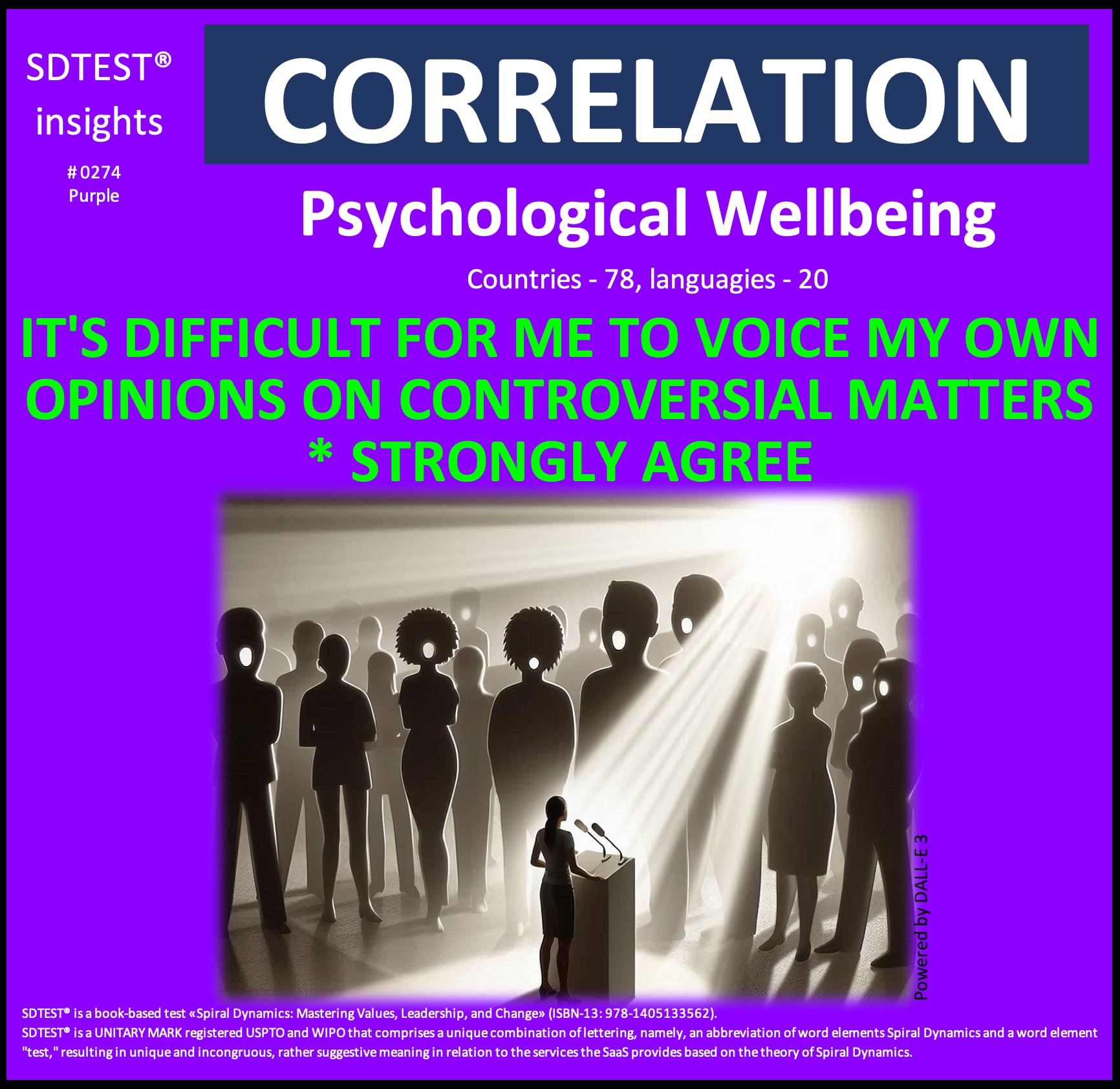
This positive correlation of 0.0929 between strongly agreeing that "It's difficult for me to voice my own opinions on controversial matters" and the Purple stage offers intriguing insights when viewed through the lens of the Purple value system:
Organizational Perspective:
Organizations operating within the Purple mindset might interpret this correlation as:
- Validation of their emphasis on group harmony and adherence to traditional wisdom.
- Confirmation that individual opinions should subordinate collective beliefs and practices.
- A sign that their organizational culture successfully preserves ancestral values and communal unity.
These organizations might respond by:
- Reinforcing rituals and ceremonies that affirm collective beliefs and discourage individual dissent.
- Implementing decision-making processes that prioritize consensus and alignment with traditional practices.
- Developing mentorship programs where elders guide younger members in proper conduct and beliefs.
Team Perspective:
Teams operating from a Purple mindset might approach this correlation by:
- Viewing it as evidence of strong team cohesion and loyalty to shared values.
- Interpreting it as a need to strengthen group identity further and discourage potentially divisive individual opinions.
- Seeing it as an opportunity to deepen team members' connection to ancestral wisdom and spiritual guidance.
These teams might respond by:
- Instituting regular team rituals that reinforce shared beliefs and values.
- Encouraging team members to seek guidance from respected elders or spiritual leaders before voicing opinions.
- Developing a team "code of conduct" that emphasizes harmony and respect for traditional ways of thinking.
Individual Perspective:
Individuals aligned with the Purple value system might interpret this correlation as:
- Personal validation of their commitment to group harmony and respect for ancestral wisdom.
- An opportunity to deepen their connection to the community by suppressing potentially divisive personal opinions.
- Confirmation that spiritual and traditional guidance should be prioritized over individual reasoning.
These individuals might respond by:
- Seeking more frequent counsel from community elders or spiritual leaders on controversial matters.
- Engaging in personal rituals or practices to align their thoughts more closely with traditional beliefs.
- Focusing on strengthening their role within the community rather than developing individual viewpoints.
This correlation, viewed through the Purple lens, suggests that those operating at the Purple level may find it challenging to voice individual opinions on controversial matters due to their strong emphasis on group harmony, tradition, and spiritual guidance. It implies that the Purple value system's characteristics of community belonging, respect for ancestral wisdom, and belief in supernatural forces align with a hesitancy to express personal views that might disrupt the collective narrative.
This interpretation doesn't necessarily imply that Purple-oriented individuals or organizations cannot address controversial issues. Rather, it suggests that they approach such matters through the lens of collective wisdom, spiritual guidance, and traditional practices rather than individual reasoning. The challenge lies in addressing new or complex issues while remaining true to ancestral values and maintaining the strong sense of community that characterizes the Purple value system.
From this perspective, the correlation invites us to explore the complex dynamics between individual expression and group cohesion in traditional, spiritually-oriented communities. It prompts us to ask: How do Purple-oriented societies maintain stability and unity while navigating potentially divisive issues? What role do rituals and spiritual practices play in mediating conflicting viewpoints?
Ultimately, this correlation speaks to the profound influence of collective beliefs and ancestral traditions on individual expression within Purple-oriented cultures. It reminds us that personal opinions on controversial matters in the Purple worldview are often considered secondary to maintaining group harmony and upholding time-honored wisdom.
In our analysis of the poll "Where would be your next most exciting opportunity?" we found an intriguing positive correlation that warrants closer examination:
0.0886 between the International Market leader and the Red stage.
The critical value of the correlation coefficient for a normal distribution, by William Sealy Gosset (Student) r = 0.0569. This positive correlation of 0.0886 meets the reliability criteria but does not necessarily imply causation.

This positive correlation of 0.0886 between International Market leadership and the Red stage offers intriguing insights into why this is seen as the next most exciting opportunity when viewed through the lens of the Red value system:
Organizational Perspective:
Organizations operating within the Red mindset might see International Market leadership as the most exciting opportunity because:
- It represents the ultimate arena for demonstrating power and dominance on a global scale.
- It offers unparalleled potential for resource acquisition and territory expansion beyond local constraints.
- It provides a platform to crush various competitors, proving superiority across diverse markets.
These organizations might respond by:
- Aggressively targeting international markets with a "conquer or be conquered" mentality.
- Implementing ruthless strategies to quickly dominate new territories, disregarding local customs or long-term consequences.
- Celebrating and rewarding the organization's most aggressive and successful international expansion efforts.
Team Perspective:
Teams operating from a Red mindset might view International Market leadership as the most exciting next step because:
- It offers a chance to prove its supremacy by outperforming local and global competitors.
- It presents new challenges and territories to conquer, satisfying their thirst for immediate action and excitement.
- It provides opportunities for individual team members to gain power and recognition on an international stage.
These teams might respond by:
- Competing fiercely among themselves for the chance to lead international expansion efforts.
- Adopting a "win at all costs" mentality in international negotiations and market entry strategies.
- Glorifying risk-taking and aggressive tactics that yield quick wins in new markets.
Individual Perspective:
Individuals aligned with the Red value system might see International Market leadership as the most thrilling opportunity because:
- It offers a path to personal glory and power that transcends national boundaries.
- It provides a larger stage for self-expression and asserting individual dominance.
- It presents the ultimate challenge to prove one's strength and superiority against global competition.
These individuals might respond by:
- Aggressively pursuing international assignments or roles that offer the most power and visibility.
- Disregarding cultural nuances or ethical considerations favoring personal gain and immediate results.
- Boasting about their international conquests and using them to intimidate or dominate others within their organization.
This correlation, viewed through the Red lens, suggests that International Market leadership is the next most exciting opportunity because it aligns perfectly with the Red value system's core drivers. It offers a larger arena for exercising power, a greater challenge for self-expression, and more opportunities for immediate gratification and dominance.
The excitement stems from the prospect of unrestricted growth and the potential to assert one's will across diverse markets and cultures. For those in the Red stage, the international market represents a vast, untamed territory ripe for conquest, free from the constraints and familiarity of domestic markets.
Moreover, the correlation implies that the characteristics of the Red value system – impulsiveness, aggression, and a focus on immediate results – may be perceived as assets in the dynamic and often cutthroat world of international business. This alignment fuels the excitement, as it suggests that embracing these Red traits could lead to success on the global stage.
Ultimately, this correlation highlights how the Red worldview transforms the complexities and challenges of international markets into an exhilarating opportunity for power projection and personal or organizational aggrandizement. It underscores the appeal of global conquest to those operating within a value system that prioritizes dominance, self-interest, and immediate action above all else.
-0.0877 between the Connect with Others and the Blue stage.
The critical value of the correlation coefficient for a normal distribution, by William Sealy Gosset (Student) r = 0.0667. This negative correlation of -0.0877 meets the reliability criteria but does not necessarily imply causation.
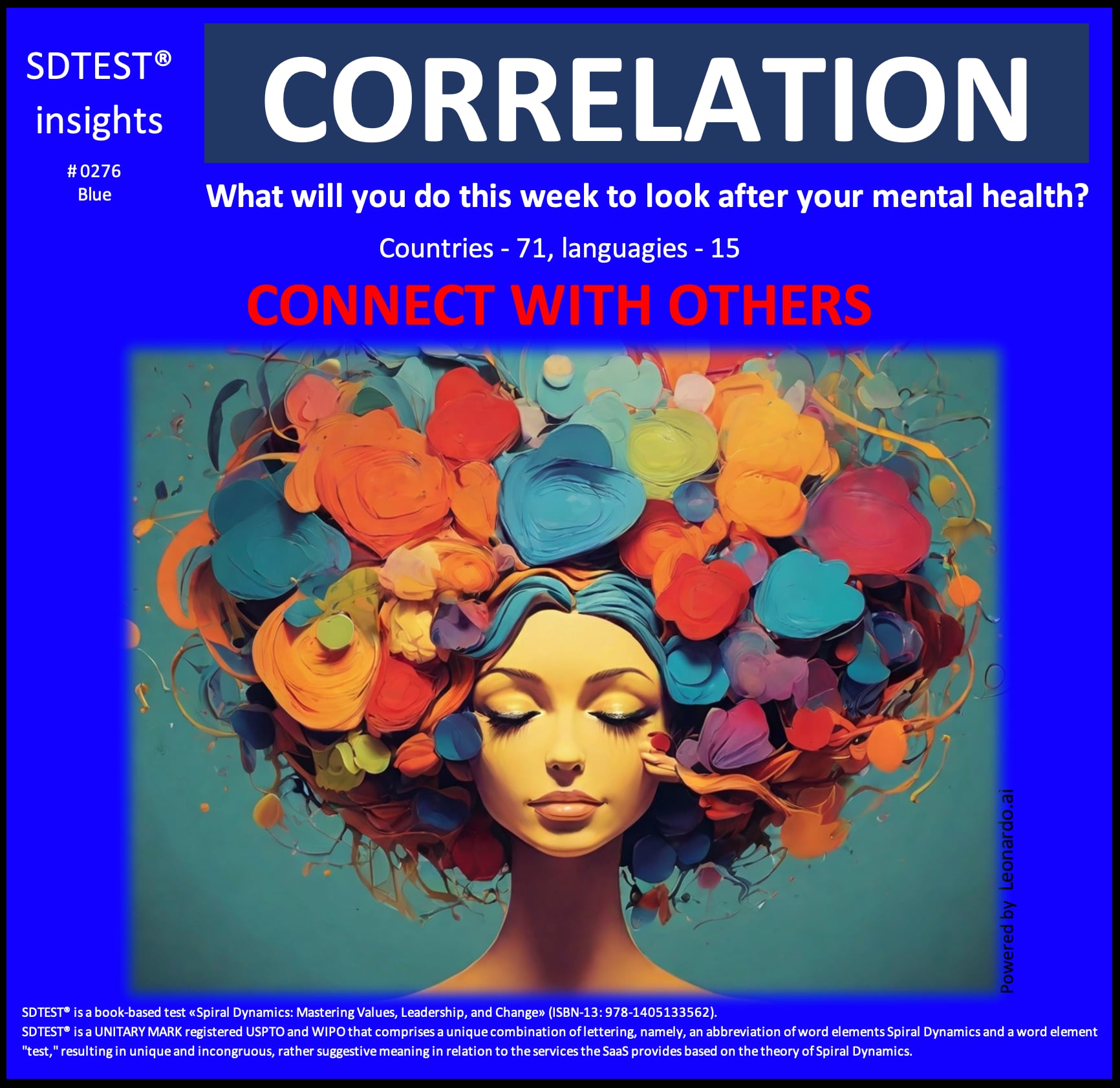
This negative correlation of -0.0877 between Connecting with Others and the Blue stage offers intriguing insights into why people at this stage might be less inclined to engage in this mental health practice when viewed through the lens of the Blue value system:
Organizational Perspective:
Organizations operating within the Blue mindset might interpret this correlation as:
- A reflection of the prioritization of duty and organizational structure over individual needs.
- An indication that mental health should be addressed through established, formal channels rather than informal connections.
- A sign that personal struggles should be handled privately, in line with traditional values of stoicism and self-reliance.
These organizations might respond by:
- Implementing rigid, top-down mental health protocols that focus on maintaining order and productivity.
- Discouraging informal social connections that might distract from prescribed duties and hierarchies.
- Emphasizing the importance of following established rules and procedures for addressing mental health concerns.
Team Perspective:
Teams operating from a Blue mindset might approach this correlation by:
- Viewing it as a confirmation that team cohesion should be based on shared duties rather than personal connections.
- Interpreting it as a need to focus on formal team-building exercises rather than spontaneous social interactions.
- Seeing it as a justification for maintaining professional distance between team members.
These teams might respond by:
- Strictly adhering to formal communication channels and support within the team structure.
- Discouraging personal conversations or connections that fall outside of official team functions.
- Emphasizing the importance of individual responsibility and self-reliance in managing mental health.
Individual Perspective:
Individuals aligned with the Blue value system might interpret this correlation as:
- Validation of the belief that personal struggles should be handled privately and stoically.
- A reminder that one's duty to the organization or society precedes personal needs.
- Confirmation that seeking help from others might be seen as a sign of weakness or lack of self-discipline.
These individuals might respond by:
- Avoiding discussions about personal mental health issues with colleagues or peers.
- Rigidly adhering to prescribed methods for addressing mental health concerns, such as formal counseling services.
- Prioritizing their responsibilities and duties over personal connections or social support.
This correlation, viewed through the Blue lens, suggests that those operating at the Blue level may be less inclined to connect with others for mental health support due to their focus on order, tradition, and duty. It implies that the Blue value system's characteristics of conformity, self-discipline, and adherence to established norms may discourage informal social connections for mental health purposes.
The reluctance to connect with others for mental health support in the Blue stage may stem from several factors:
- Emphasis on Structure and Hierarchy: The Blue stage values clear structures and hierarchies. Seeking support outside these established channels may be seen as disruptive or inappropriate.
- Duty Over Personal Needs: There's a strong emphasis on fulfilling one's duties and responsibilities. Taking personal time to connect with others might be perceived as neglecting these obligations.
- Traditionalism and Stoicism: Traditional values often associated with the Blue stage may encourage individuals to handle personal struggles privately and stoically.
- Fear of Judgment: In a system that values conformity and adherence to norms, individuals might fear being judged or seen as weak if they openly discuss mental health concerns.
- Rigid Problem-Solving Approaches: The Blue stage prefers established, rule-based solutions. Informal social connections might be seen as too unstructured or unreliable for addressing mental health issues.
This correlation prompts us to consider how value systems influence approaches to mental health support. It raises questions about the potential limitations of a strictly Blue approach to mental well-being and the challenges of promoting social connection in environments prioritizing order and tradition over individual emotional needs.
Ultimately, this correlation highlights the complex interplay between cultural values and mental health practices. It suggests that in Blue-dominant environments, alternative strategies may be needed to promote mental health support that aligns with the prevailing value system while still addressing the critical need for social connection.
In our analysis of the poll "Ageism in Life" (Have you ever experienced a situation in which your age seemed to contribute to a problem or uncomfortable situation?), we found an intriguing positive correlation that warrants closer examination:
0.0946 between the No, I have never experienced a situation in which my age seemed to contribute to a problem or uncomfortable situation and the Orange stage.
The critical value of the correlation coefficient for a normal distribution, by William Sealy Gosset (Student) r = 0.0802. This positive correlation of 0.0946 meets the reliability criteria but does not necessarily imply causation.
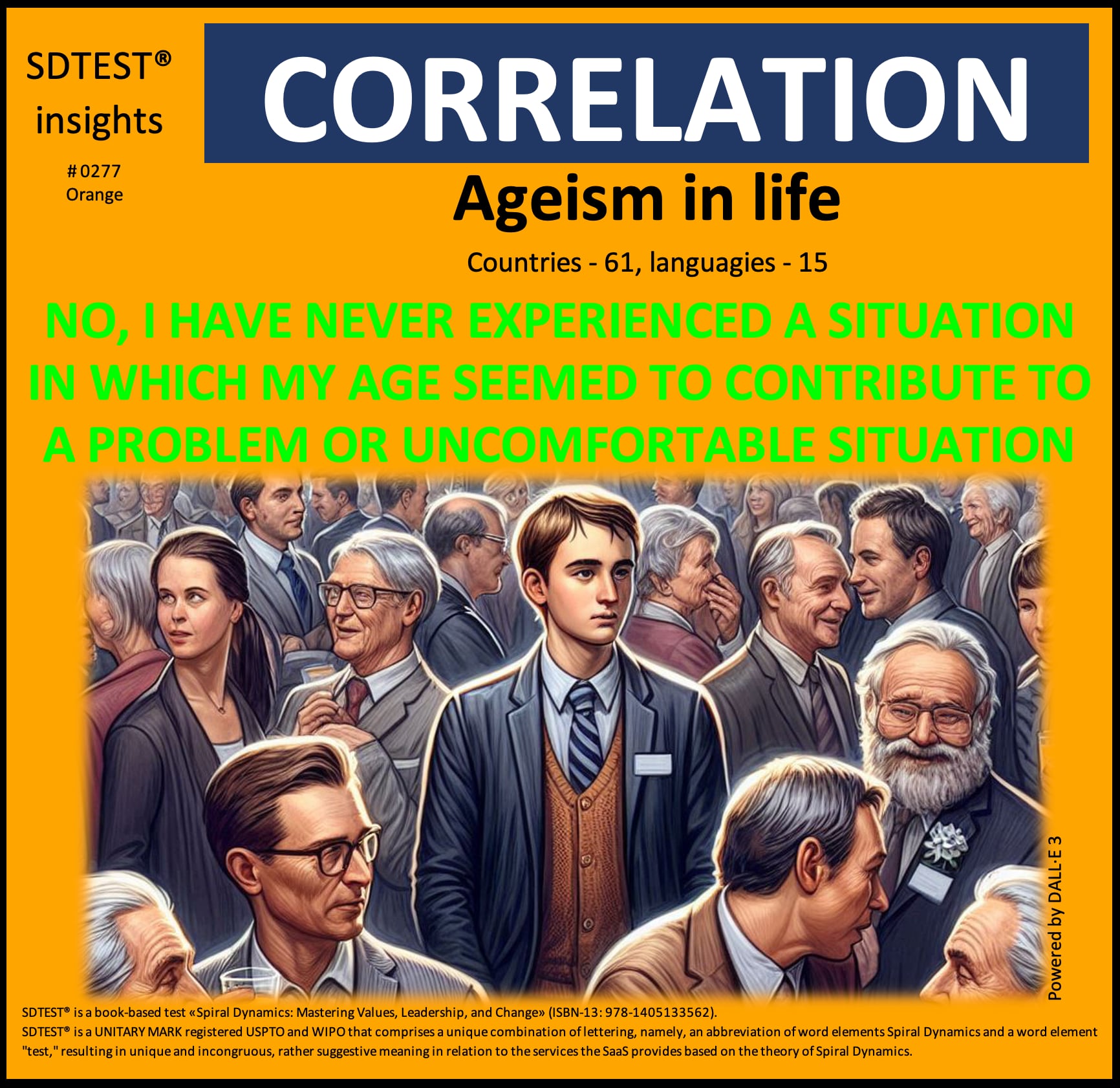
This positive correlation of 0.0946 between never experiencing age-related problems and the Orange stage offers intriguing insights when viewed through the lens of the Orange value system:
Organizational Perspective:
Organizations operating within the Orange mindset might interpret this correlation as:
- Validation of their merit-based systems and focus on competence over seniority.
- Evidence that their emphasis on innovation and adaptability mitigates age-related issues.
- Confirmation that their goal-oriented culture transcends age-based limitations.
These organizations might respond by:
- Reinforcing performance-based evaluation systems that prioritize results over tenure.
- Investing in continuous learning and development programs to keep all employees current, regardless of age.
- Marketing their culture where skills and achievements matter more than age or experience.
Team Perspective:
Teams operating from an Orange mindset might approach this correlation by:
- Viewing it as proof that their focus on efficiency and results naturally minimizes age-related biases.
- Interpreting it as justification for assembling teams based on skills rather than age diversity.
- Seeing it as validation of their competitive, goal-driven approach that values performance over seniority.
These teams might respond by:
- Implement project management techniques that focus on individual contributions rather than age or experience.
- Encouraging a culture of continuous skill development to maintain relevance regardless of age.
- Celebrating achievements and innovations that come from team members of all ages.
Individual Perspective:
Individuals aligned with the Orange value system might interpret this correlation as:
- Personal validation of their focus on continuous self-improvement and adaptability.
- Evidence that their emphasis on skills and results over age-based respect is justified.
- Confirmation that their rational, goal-oriented approach to career development mitigates age-related challenges.
These individuals might respond by:
- Doubling down on skill acquisition and staying current with industry trends to remain competitive.
- Actively seeking out challenging projects showcasing their abilities, regardless of age.
- Promoting a mindset that age is irrelevant in the face of competence and achievement.
This correlation, viewed through the Orange lens, suggests that those operating at the Orange level may be less likely to experience age-related problems due to their focus on reason, achievement, and measurable results. It implies that the Orange value system's characteristics of rationality, goal orientation, and emphasis on competence may create an environment where age becomes less relevant.
The reasons why individuals in the Orange stage might not experience age-related problems or uncomfortable situations could include:
- Merit-based Culture: The Orange stage values achievement and results over traditional markers like age or seniority, potentially reducing age-based discrimination.
- Continuous Learning: With a focus on progress and efficiency, individuals in this stage will likely engage in continuous learning, keeping their skills relevant regardless of age.
- Adaptability: The Orange value system encourages adaptability and innovation, which can help individuals stay valuable and avoid age-related stereotypes.
- Goal-oriented Mindset: Focusing on concrete goals and objectives directs attention away from age and towards measurable outcomes.
- Technological Proficiency: The Orange stage's emphasis on technology and scientific methods may lead to greater technological adaptability across age groups.
This correlation prompts us to consider how value systems influence perceptions of age in professional and social contexts. It raises questions about the potential benefits of an Orange approach in mitigating age-related biases while also inviting scrutiny of potential blind spots or unintended consequences of this worldview.
Ultimately, this correlation highlights the complex interplay between cultural values and age-related experiences. It suggests that the focus on competence, achievement, and rationality in Orange-dominant environments may create a context where age becomes less of a defining or limiting factor in one's experiences and opportunities.
In our analysis of the poll "A.I. and the end of civilization" (by Elon Musk), we found an intriguing positive correlation that warrants closer examination:
0.0832 between the State should exercise control over the development of the artificial intelligence / Somewhat agree and the Green stage.
The critical value of the correlation coefficient for a normal distribution, by William Sealy Gosset (Student) r = 0.0786. This positive correlation of 0.0832 meets the reliability criteria but does not necessarily imply causation.
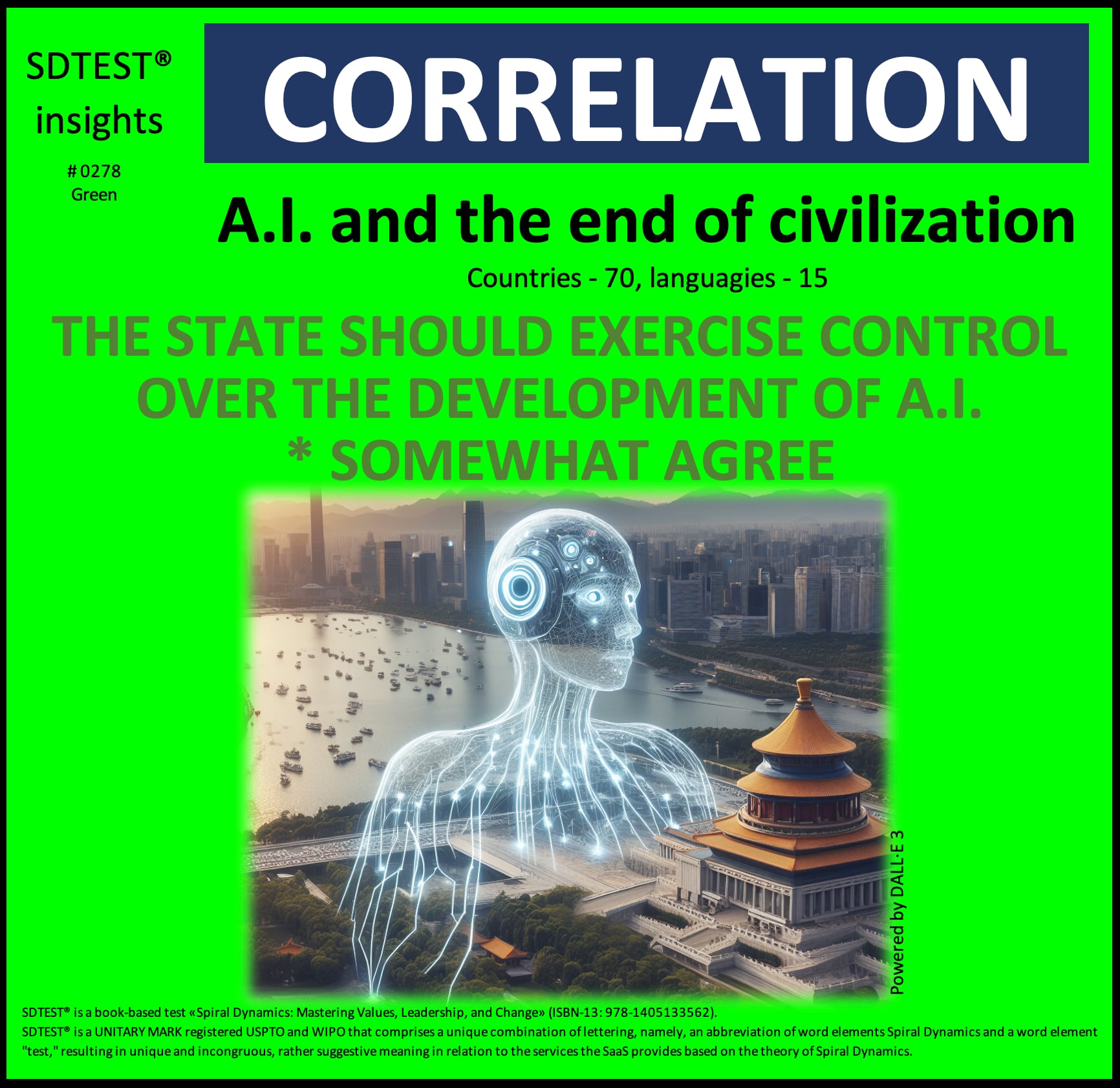
This positive correlation of 0.0832 between somewhat agreeing that the state should exercise control over AI development and the Green stage offers intriguing insights when viewed through the lens of the Green value system:
Organizational Perspective:
Organizations operating within the Green mindset might interpret this correlation as:
- Validation of their holistic approach to technological development, considering societal and ecological impacts.
- Support collaborative governance models that include diverse stakeholders in AI regulation.
- Confirmation of the need for ethical frameworks in AI development that prioritize collective well-being.
These organizations might respond by:
- Advocating for inclusive, multi-stakeholder approaches to AI governance.
- Implementing transparent AI development processes that consider social and environmental impacts.
- Fostering partnerships between public, private, and civil society sectors for responsible AI innovation.
Team Perspective:
Teams operating from a Green mindset might approach this correlation by:
- Viewing it as a call to integrate ethical considerations and community impact into their AI projects.
- Interpreting it as support for more diverse and interdisciplinary AI development teams.
- Seeing it as validation for prioritizing sustainability and social responsibility in AI applications.
These teams might respond by:
- Incorporating ethical review processes and community feedback loops in AI development cycles.
- Encouraging team members to consider the broader societal implications of their work.
- Promoting collaborative problem-solving that balances technological advancement with social and ecological concerns.
Individual Perspective:
Individuals aligned with the Green value system might interpret this correlation as:
- Personal validation of their concern for the ethical implications of AI on society and the environment.
- Evidence supporting their belief in the need for collective responsibility in technological advancement.
- Confirmation of the importance of considering diverse perspectives in AI governance.
These individuals might respond by:
- Actively engaging in public discussions and forums on ethical AI development.
- Seeking out opportunities to contribute to community-oriented AI projects.
- Advocating for inclusive decision-making processes in AI governance within their organizations.
This correlation, viewed through the Green lens, suggests that those operating at the Green level may be more inclined to support some degree of state control over AI development due to their focus on community well-being, ecological concerns, and holistic thinking. It implies that the Green value system's cooperation, sustainability, and systems thinking characteristics align with a nuanced approach to AI governance.
The reasons why individuals in the Green stage might somewhat agree with state control over AI development could include:
- Holistic Perspective: The Green stage emphasizes a systems-thinking approach, recognizing the complex interconnections between AI development and its societal and environmental impacts.
- Concern for Collective Well-being: Green values prioritize the well-being of all, potentially leading to support for oversight that ensures AI benefits society as a whole.
- Ecological Awareness: With a focus on sustainability, there may be concern about the environmental impacts of unchecked AI development.
- Inclusive Governance: The Green stage values diverse perspectives, potentially seeing state control as a way to ensure multiple stakeholders are considered in AI development.
- Ethical Considerations: A strong emphasis on ethics in the Green stage may lead to support for regulations that ensure AI aligns with societal values.
This correlation prompts us to consider how value systems influence perspectives on technological governance. It raises questions about balancing innovation with social responsibility and creating inclusive, ethically aligned approaches to AI development.
Importantly, this correlation's "somewhat agree" stance aligns well with the Green stage's tendency towards nuanced, non-binary thinking. It suggests a recognition of the complex trade-offs involved in AI governance rather than a simplistic pro- or anti-regulation stance.
Ultimately, this correlation highlights the complex interplay between cultural values and attitudes toward technological regulation. It suggests that in Green-dominant environments, approaches to AI governance may prioritize collaborative, ethically informed, and socially responsible frameworks that balance technological advancement with broader societal and ecological considerations.
In our analysis of the poll "Why do people procrastinate?" we found an intriguing negative correlation that warrants closer examination:
-0.1094 between the Plate Too Full: Having too many tasks or responsibilities, leaving little time or energy for specific tasks / Not Applicable and the Yellow stage.
The critical value of the correlation coefficient for a normal distribution, by William Sealy Gosset (Student) r = 0.0719. This negative correlation of -0.1094 meets the reliability criteria but does not necessarily imply causation.
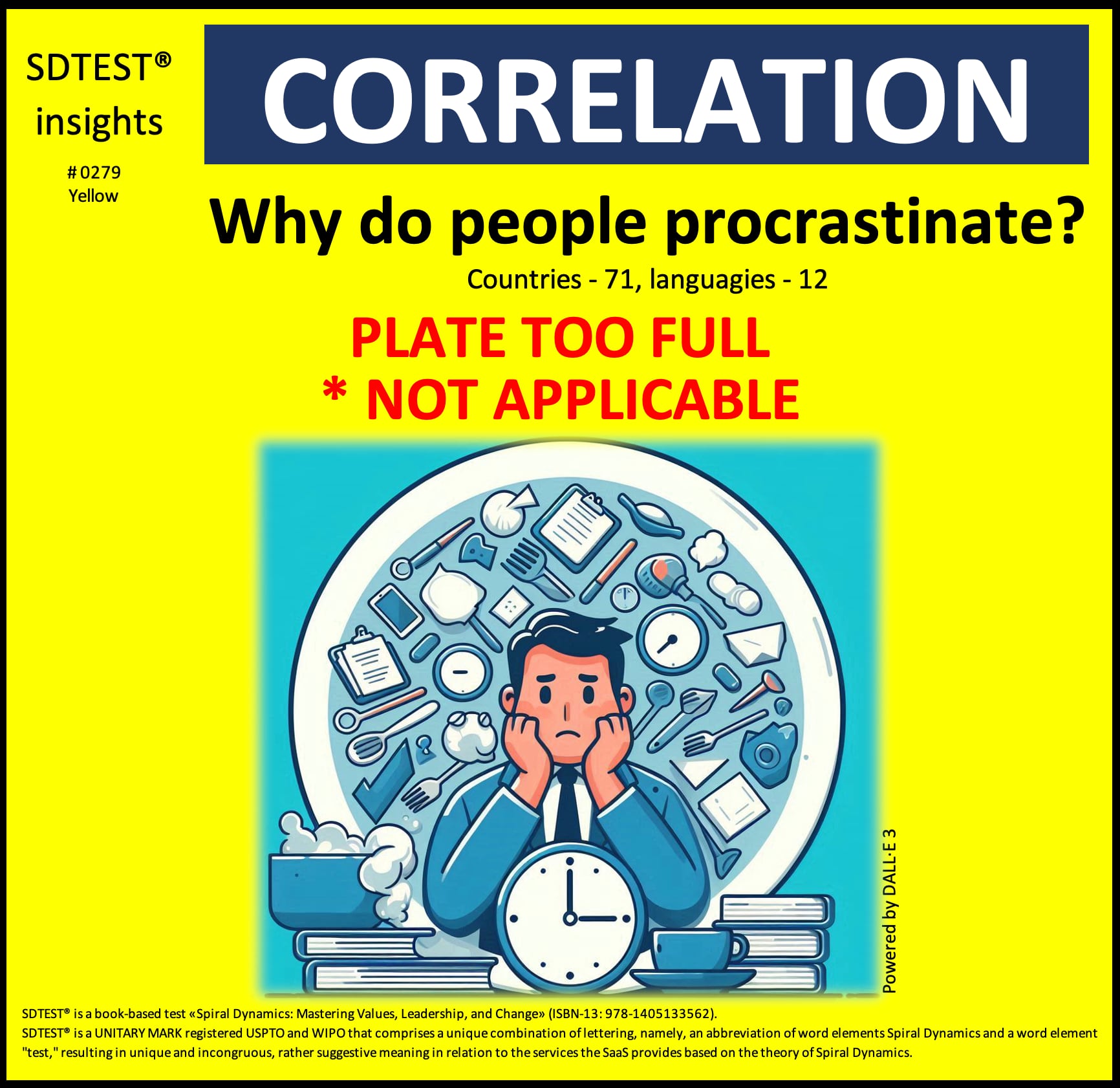
This positive relationship between "Plate Too Full" as a reason for procrastination and the Yellow stage offers intriguing insights when viewed through the lens of the Yellow value system:
Organizational Perspective:
Companies operating within the Yellow mindset might interpret this correlation as:
- Recognition of the complex, interconnected nature of tasks and responsibilities in advanced systems.
- Validation of the need for integrative strategies to effectively manage diverse and numerous priorities.
- An opportunity to leverage their holistic understanding to address the challenges of overcommitment.
These organizations might respond by:
- Implementing flexible work structures that acknowledge the multifaceted nature of roles and responsibilities.
- Developing innovative time management and prioritization tools that align with systems thinking.
- Encouraging a culture of mindful commitment and strategic task selection.
Team Perspective:
Teams operating from a Yellow mindset might approach this correlation by:
- Viewing it as an opportunity to apply their integrative thinking to balance multiple priorities more effectively.
- Interpreting it as a call to leverage diverse perspectives in addressing workload challenges.
- Seeing it as validation for exploring new productivity and task management paradigms.
These teams might respond by:
- Adopting collaborative workload distribution approaches that consider individual capacities and team synergies.
- Implementing regular reflection sessions to assess and adjust collective commitments and priorities.
- Exploring innovative project management methodologies that align with Yellow values of flexibility and integration.
Individual Perspective:
Individuals aligned with the Yellow value system might interpret this correlation as:
- A reflection of their ability to perceive and engage with various meaningful tasks and responsibilities.
- An opportunity to apply their integrative thinking to personal time and energy management.
- A challenge to further develop their capacity to navigate complexity without becoming overwhelmed.
These individuals might respond by:
- Embracing the complexity of their full plate while seeking innovative ways to integrate and manage diverse responsibilities.
- Developing personalized systems for task prioritization that align with their holistic worldview.
- Viewing their full plate as an opportunity for personal growth and integrating diverse skills and experiences.
This correlation, viewed through the Yellow lens, suggests that those operating at the Yellow level may be more likely to experience and acknowledge having a full plate as a reason for procrastination. It implies that the Yellow value system's characteristics of seeing multiple perspectives and understanding complex systems may lead to a greater awareness of the multitude of tasks and responsibilities one faces.
The reasons why "Plate Too Full" might be particularly applicable as a cause of procrastination in the Yellow stage could include:
- Heightened Awareness: The Yellow stage's ability to see multiple perspectives may lead to greater recognition of the various tasks and responsibilities one could potentially take on.
- Systemic Understanding: Their grasp of complex systems might make them more aware of the interconnected nature of tasks, potentially leading to a sense of having numerous vital responsibilities.
- Broad Engagement: The Yellow value system's integrative approach may lead individuals to engage with various tasks and responsibilities, potentially leading to over-commitment.
- Perfectionist Tendencies: The desire to address issues holistically might lead to taking on more than is manageable in pursuit of comprehensive solutions.
- Challenge Seeking: The Yellow stage's focus on personal growth might lead individuals to take on new challenges, potentially overextending themselves continuously.
This correlation prompts us to consider how advanced value systems interact with the practical challenges of time and energy management. It raises questions about balancing a holistic, integrative worldview with the realities of limited resources and the potential for over-commitment.
Ultimately, this correlation highlights the complex interplay between sophisticated cognitive frameworks and day-to-day task management. It suggests that in Yellow-dominant environments, while there may be a greater capacity for handling complexity, there's also a heightened awareness of the diversity of tasks and responsibilities, which can lead to feelings of being overwhelmed and subsequent procrastination.
In our analysis of the poll "Gender difference in building self-confidence" (by IFD Allensbach), we found an intriguing negative correlation that warrants closer examination:
-0.1543 between the Earnings and the Turquoise stage.
The critical value of the correlation coefficient for a normal distribution, by William Sealy Gosset (Student) r = 0.1138. This negative correlation of 0.0514 meets the reliability criteria but does not necessarily imply causation.
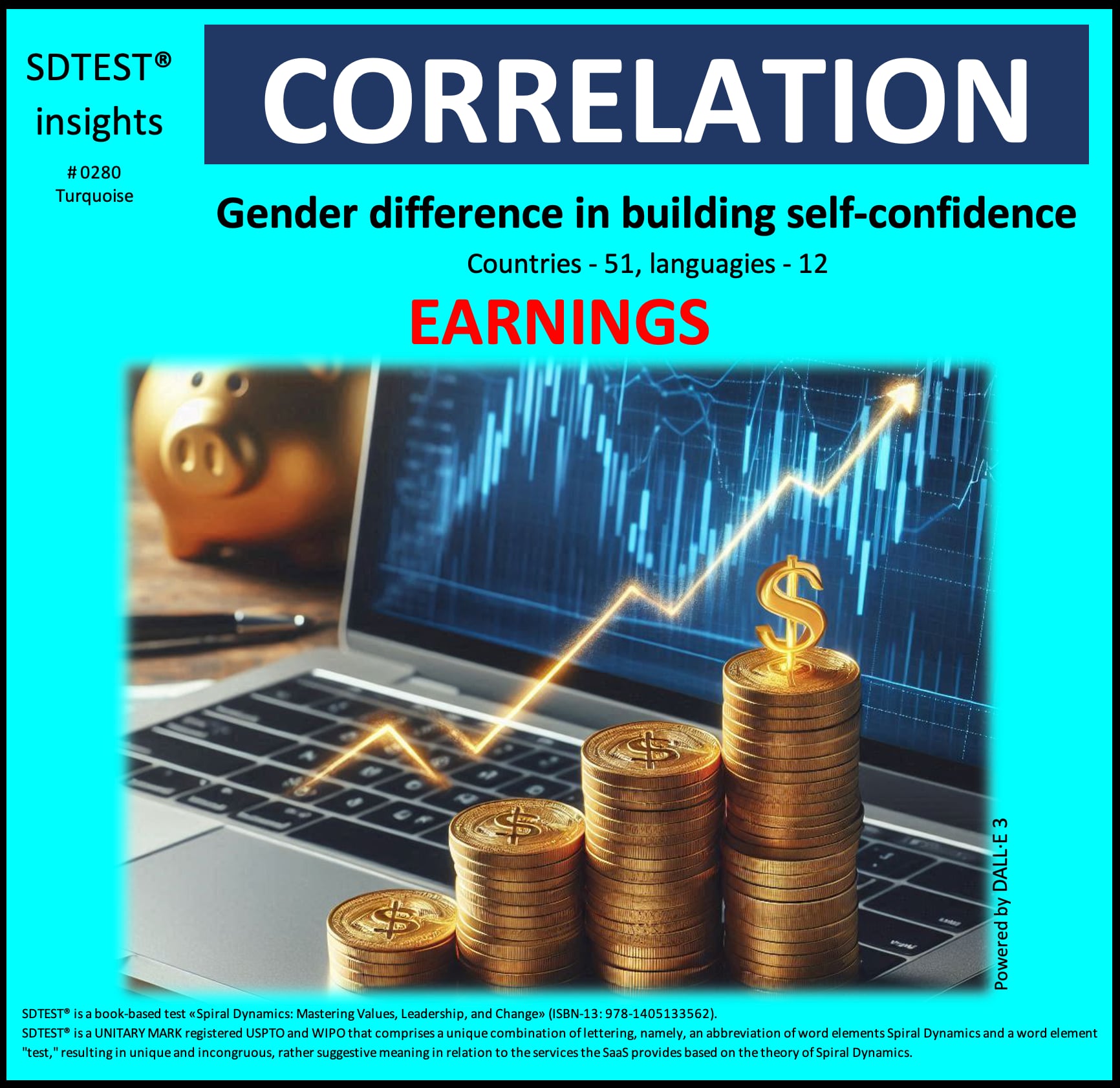
This negative correlation of -0.1543 between Earnings as a factor in building self-confidence and the Turquoise stage offers intriguing insights when viewed through the lens of the Turquoise value system:
Organizational Perspective:
Companies operating within the Turquoise mindset might interpret this correlation as:
- Validation of their holistic approach to employee well-being beyond financial compensation.
- Confirmation that their focus on purpose-driven work and interconnectedness resonates with employees.
- Evidence supporting their emphasis on sustainable and ecological business practices over pure profit motives.
These organizations might respond by:
- Implementing comprehensive well-being programs that address spiritual, emotional, and environmental needs alongside financial ones.
- Redefining success metrics to include ecological impact, social harmony, personal growth, and financial performance.
- Fostering a culture that values contribution to the greater good over individual financial gain.
Team Perspective:
Teams operating from a Turquoise mindset might approach this correlation by:
- Viewing it as an affirmation of their collaborative, non-hierarchical structures that don't emphasize individual earnings.
- Interpreting it supports their focus on collective growth and holistic team development.
- Seeing it as validation for prioritizing meaningful, interconnected work over individual financial incentives.
These teams might respond by:
- Developing new ways to recognize and celebrate contributions that align with Turquoise values.
- Implementing team-building activities that emphasize spiritual growth and connection with nature.
- Encouraging team members to find self-confidence through their impact on broader systems rather than personal earnings.
Individual Perspective:
Individuals aligned with the Turquoise value system might interpret this correlation as:
- Personal validation of their shift away from materialistic measures of self-worth.
- Evidence supporting their focus on spiritual growth and interconnectedness as sources of confidence.
- Confirmation of the value they place on contributing to global well-being over personal financial gain.
These individuals might respond by:
- Seeking out roles and opportunities that align with their holistic worldview, even if they offer lower financial compensation.
- Deriving self-confidence from understanding complex systems and their place within them.
- Actively engaging in practices that deepen their connection to nature and the universe as a source of self-assurance.
This correlation, viewed through the Turquoise lens, suggests that those operating at the Turquoise level may be less likely to derive self-confidence from earnings. It implies that the Turquoise value system's characteristics of holistic thinking, ecological awareness, and focus on interconnectedness align with alternative sources of self-confidence.
The reasons why Earnings might not be a significant factor in building self-confidence in the Turquoise stage could include:
- Holistic Perspective: The Turquoise stage emphasizes the interconnectedness of all things, potentially leading to a de-emphasis on individual financial gain as a measure of worth.
- Ecological Awareness: With a strong focus on sustainability and harmony with nature, material wealth may be seen as less important than ecological balance.
- Spiritual Connection: This stage's deep spiritual connection may provide a more profound source of self-confidence than financial success.
- Global Consciousness: A focus on the well-being of all humanity and the planet may shift the basis of self-confidence from personal earnings to global impact.
- Non-materialistic Values: The Turquoise stage often transcends materialistic concerns, potentially reducing the importance of earnings in self-evaluation.
This correlation prompts us to consider how advanced value systems influence perceptions of self-worth and confidence. It raises questions about the potential benefits of a Turquoise approach in fostering more holistic and sustainable bases for self-confidence while also inviting scrutiny of how this worldview interacts with practical economic realities.
Ultimately, this correlation highlights the complex interplay between cultural values, personal development, and societal measures of success. It suggests that in Turquoise-dominant environments, sources of self-confidence may be more closely tied to spiritual growth, ecological harmony, and contribution to global well-being rather than individual financial achievement.
What insights do you gain from today's correlation? How might we study this relationship more carefully before deducing causation?
We welcome respectful and wise perspectives! Stay tuned every week as we share more results and insights.
After login or registration, free access to the poll results in the FAQ section.
2024.10.06
FearpersonqualitiesprojectorganizationalstructureRACIresponsibilitymatrixCritical ChainProject Managementfocus factorJiraempathyleadersbossGermanyChinaPolicyUkraineRussiawarvolatilityuncertaintycomplexityambiguityVUCArelocatejobproblemcountryreasongive upobjectivekeyresultmathematicalpsychologyMBTIHR metricsstandardDEIcorrelationriskscoringmodelGame TheoryPrisoner's Dilemma
Валерий Косенко
Продукт хуҗасы SaaS SDTEST®
Валерий 1993-нче елда социаль педагог-психолог булып квалификацияләнде һәм шуннан соң үз белемен проект белән идарә итүдә кулланды.
Валерий 2013-нче елда магистр дәрәҗәсен һәм проект һәм программа менеджеры квалификациясен алды. Магистр программасы кысаларында ул Проект mл картасы (GPM Deutsche Gesellschaft für Projektmanagement e. V.) һәм Спираль Динамика белән танышты.
Валерий - V.U.C.A.ның билгесезлеген тикшерү авторы. Спираль динамика һәм психологиядә математик статистика кулланып концепция, һәм 38 халыкара сораштыру.










